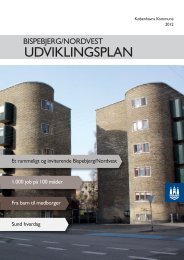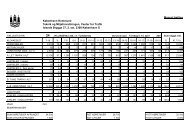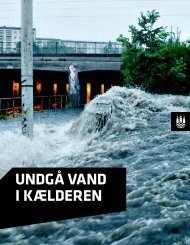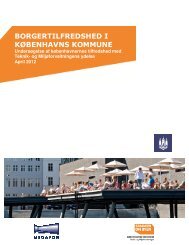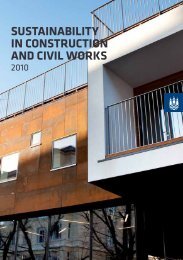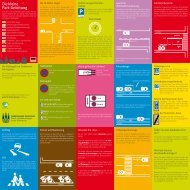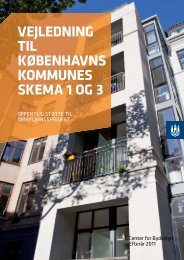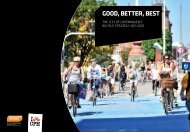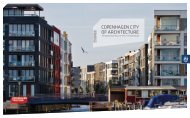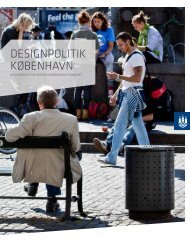INTEGRATED URBAN RENEWAL - Itera
INTEGRATED URBAN RENEWAL - Itera
INTEGRATED URBAN RENEWAL - Itera
- No tags were found...
Create successful ePaper yourself
Turn your PDF publications into a flip-book with our unique Google optimized e-Paper software.
Selection of new areas for renewal<br />
Why is it important to continue with integrated urban<br />
renewal<br />
The City of Copenhagen views integrated urban renewal as an<br />
important initiative of great importance to citizens and the<br />
city as a whole. Over recent years, Copenhagen has enjoyed<br />
positive growth, which has transformed the city physically,<br />
socially and economically. Such positive developments have<br />
changed many of the city's needs and disadvantaged areas<br />
now require a different kind of attention and effort than the<br />
first district-based area renewals performed by the City of Copenhagen.<br />
In step with such changing needs, the framework<br />
of district-based initiatives has also changed. As previous<br />
integrated urban renewals had much greater financial scope<br />
than is the case today, the conditions under which integrated<br />
urban renewal is performed have changed. The City of<br />
Copenhagen therefore works strategically with area renewal<br />
as a means of ensuring that disadvantaged areas of the city<br />
can develop and utilise the resources they contain in the best<br />
possible way.<br />
Area renewals help to relieve unfavourable development<br />
trends and prevent potential downwardly spiralling development<br />
patterns in run down and socially underprivileged areas<br />
of the city. The effort is unified and is both a long-term and<br />
broad-pallet initiative intended to help improve the quality of<br />
life of residents and to create sustainable urban areas – socially,<br />
physically and culturally.<br />
How does the process work<br />
Before an application is submitted to the Ministry of Housing,<br />
Urban and Rural Affairs, the process has been underway for<br />
almost a year. The process begins with the Technical and Environmental<br />
Department performing a screening of the city's<br />
physical and socio-economic condition. In 2010, the Technical<br />
and Environmental Administration drew up a new, webbased,<br />
socio-economic map, which now is used for this preliminary,<br />
all-embracing screening of Copenhagen. As a result<br />
the city can be screened for a greater number of parameters.<br />
Socio-Economic Map of Copenhagen (SØK)<br />
SØK is a web-based housing and socio-economic map of<br />
Copenhagen. The map contains a number of indicators<br />
which help the Technical and Environmental Administration<br />
determine which parts of the city face particular challenges<br />
concerning housing and socio-economic parameters. Among<br />
other things, the map will be used to select new integrated<br />
urban renewal districts and to analyse individual districts so<br />
that the efforts can be planned to better target the challenges<br />
present in the area.<br />
The indicators in the map are of both physical and social<br />
character:<br />
With respect to physical indicators, the map can identify/analyse<br />
the areas with a high proportion of:<br />
• small flats (under 60 m²)<br />
• flats which lack basic installations (toilet/bath/central heating)<br />
• residents who live in few m²<br />
With respect to socio-economic indicators, the map identified<br />
the areas with a high proportion of:<br />
residents outside the workforce<br />
• residents with a short educational background<br />
8 9<br />
residents with low incomes<br />
On the basis of this screening, a number of areas are selected<br />
in which the physical and social challenges are most highly<br />
concentrated and which meet the other criteria set by the<br />
Ministry of Housing, Urban and Rural Affairs for integrated<br />
urban renewal districts (e.g. a high proportion of flats which<br />
are owner-occupied, cooperatively owned or privately let).<br />
The Technical and Environmental Administration then<br />
performs additional analyses based on observations in the<br />
area and interviews with local interest groups. Among other<br />
things, these analyses determine how the area looks and<br />
which potentials and resources it contains. For example, are<br />
there any green spaces Are the buildings and streets in good<br />
condition Is there life on the streets Do people feel safe in<br />
the area<br />
The areas which have greatest need for renewal are then selected<br />
after discussions involving several municipal departments.<br />
The selection is presented to the Technical and Environmental<br />
Commitee, which submits the choice of areas to



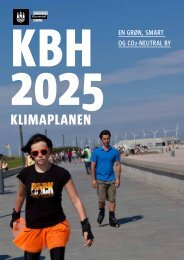
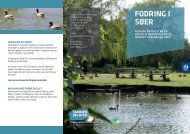
![Lokalplan 301[1] - Itera](https://img.yumpu.com/49288321/1/184x260/lokalplan-3011-itera.jpg?quality=85)
